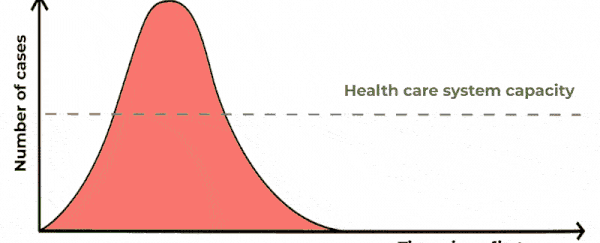Anywhere from 20 percent to 60 percent of the adults around the world may be infected with the new coronavirus SARS-CoV-2, the virus that causes the disease COVID-19. That's the estimate from leading epidemiological experts on communicable disease dynamics.
Even the best-case scenario using those numbers means nearly 40,000,000 adults will be infected in the United States alone.
Some people may start to feel fatalistic in the face of those kinds of statistics. There are no vaccines and no specific treatments for people who get sick. What's the point of fighting something that's bound to happen anyway? Why not just let the epidemic run its course?
But public health officials and medical professionals have been advocating for rapid and decisive efforts to reduce the transmission of SARS-CoV-2 as much and as early as possible.
The goal is to 'flatten the curve'. Rather than letting the virus quickly rampage through the population and burn itself out fast, the idea is to spread all those infections out over a longer period of time.
Yes, it would potentially prolong the epidemic. But in doing so, public health agencies and the health care infrastructure gain invaluable time to respond to the crisis.
Most importantly, "flattening the curve" provides an opportunity to significantly reduce deaths from COVID-19.
On the steep rise of the epidemic curve, especially when testing capacity is lacking, there is a tremendous burden on health care providers – many of whom will fall ill themselves and be forced to self-isolate, becoming unable to provide care for those in need.
At the same time, there is immense pressure placed on health care facilities where demand for patient care will outpace capacity – things like the number of hospital beds, ventilators and so on – for a significant amount of time.
 Flattening the curve is another way of saying buying more time. (Author provided)
Flattening the curve is another way of saying buying more time. (Author provided)
So yes, even if every person on Earth eventually comes down with COVID-19, there are real benefits to making sure it doesn't all happen in the next few weeks.
How, then, can people 'flatten the curve' via reducing transmission of the coronavirus? At present, with many regions of the United States and other countries seeing community members spreading COVID-19 locally, the world has entered a phase of mitigation to complement efforts to contain its spread.
As a result, we're left with an old but quite effective strategy: social distancing. It means staying out of close contact in crowded public places, avoiding mass gatherings and maintaining space – approximately six feet – between yourself and others when possible.
Social distancing requires changes in how people work, live and interact with each other. It may require canceling or avoiding big events, limiting nonessential travel and rescheduling conferences.
Traditional classroom instruction may have to move to online delivery – already happening in some colleges and universities, though less easy to do for K-12 schools.
To be clear, social distancing comes with a substantial economic cost as people aren't engaged in the same work and life activities that fuel the economy as they were just a month or two ago.
As a result, public health and government officials are faced with balancing the public health push to "flatten the curve" with desires to minimize the impact on the economy.
As the COVID-19 pandemic unfolds, public health experts across the world are collecting data and communicating information as fast as possible in an attempt to provide health care providers, research laboratories, public health agencies and policymakers with the knowledge they need to respond to the emerging threat.
In the meantime, one of the most important things individuals can do for our collective public health is to listen to the experts and follow their advice.
World Health Organization Director-General Tedros Adhanom recently commented that "We need to remember that with decisive, early action, we can slow down the virus and prevent infections."
We're not going to stamp out COVID-19. But by not just throwing up our hands and giving up, people can help address the crisis early, preventing COVID-19 from overwhelming the health care system's capacity to respond effectively.
Matthew McQueen, Director, Public Health Program and Associate Professor of Integrative Physiology, University of Colorado Boulder.
This article is republished from The Conversation under a Creative Commons license. Read the original article.
